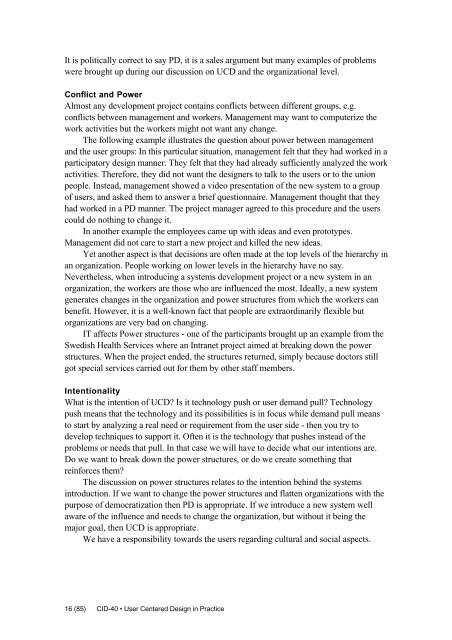User Centered Design in Practice - Problems and Possibilities
User Centered Design in Practice - Problems and Possibilities
User Centered Design in Practice - Problems and Possibilities
You also want an ePaper? Increase the reach of your titles
YUMPU automatically turns print PDFs into web optimized ePapers that Google loves.
It is politically correct to say PD, it is a sales argument but many examples of problems<br />
were brought up dur<strong>in</strong>g our discussion on UCD <strong>and</strong> the organizational level.<br />
Conflict <strong>and</strong> Power<br />
Almost any development project conta<strong>in</strong>s conflicts between different groups, e.g.<br />
conflicts between management <strong>and</strong> workers. Management may want to computerize the<br />
work activities but the workers might not want any change.<br />
The follow<strong>in</strong>g example illustrates the question about power between management<br />
<strong>and</strong> the user groups: In this particular situation, management felt that they had worked <strong>in</strong> a<br />
participatory design manner. They felt that they had already sufficiently analyzed the work<br />
activities. Therefore, they did not want the designers to talk to the users or to the union<br />
people. Instead, management showed a video presentation of the new system to a group<br />
of users, <strong>and</strong> asked them to answer a brief questionnaire. Management thought that they<br />
had worked <strong>in</strong> a PD manner. The project manager agreed to this procedure <strong>and</strong> the users<br />
could do noth<strong>in</strong>g to change it.<br />
In another example the employees came up with ideas <strong>and</strong> even prototypes.<br />
Management did not care to start a new project <strong>and</strong> killed the new ideas.<br />
Yet another aspect is that decisions are often made at the top levels of the hierarchy <strong>in</strong><br />
an organization. People work<strong>in</strong>g on lower levels <strong>in</strong> the hierarchy have no say.<br />
Nevertheless, when <strong>in</strong>troduc<strong>in</strong>g a systems development project or a new system <strong>in</strong> an<br />
organization, the workers are those who are <strong>in</strong>fluenced the most. Ideally, a new system<br />
generates changes <strong>in</strong> the organization <strong>and</strong> power structures from which the workers can<br />
benefit. However, it is a well-known fact that people are extraord<strong>in</strong>arily flexible but<br />
organizations are very bad on chang<strong>in</strong>g.<br />
IT affects Power structures - one of the participants brought up an example from the<br />
Swedish Health Services where an Intranet project aimed at break<strong>in</strong>g down the power<br />
structures. When the project ended, the structures returned, simply because doctors still<br />
got special services carried out for them by other staff members.<br />
Intentionality<br />
What is the <strong>in</strong>tention of UCD? Is it technology push or user dem<strong>and</strong> pull? Technology<br />
push means that the technology <strong>and</strong> its possibilities is <strong>in</strong> focus while dem<strong>and</strong> pull means<br />
to start by analyz<strong>in</strong>g a real need or requirement from the user side - then you try to<br />
develop techniques to support it. Often it is the technology that pushes <strong>in</strong>stead of the<br />
problems or needs that pull. In that case we will have to decide what our <strong>in</strong>tentions are.<br />
Do we want to break down the power structures, or do we create someth<strong>in</strong>g that<br />
re<strong>in</strong>forces them?<br />
The discussion on power structures relates to the <strong>in</strong>tention beh<strong>in</strong>d the systems<br />
<strong>in</strong>troduction. If we want to change the power structures <strong>and</strong> flatten organizations with the<br />
purpose of democratization then PD is appropriate. If we <strong>in</strong>troduce a new system well<br />
aware of the <strong>in</strong>fluence <strong>and</strong> needs to change the organization, but without it be<strong>in</strong>g the<br />
major goal, then UCD is appropriate.<br />
We have a responsibility towards the users regard<strong>in</strong>g cultural <strong>and</strong> social aspects.<br />
16 (85) CID-40 • <strong>User</strong> <strong>Centered</strong> <strong>Design</strong> <strong>in</strong> <strong>Practice</strong>

















